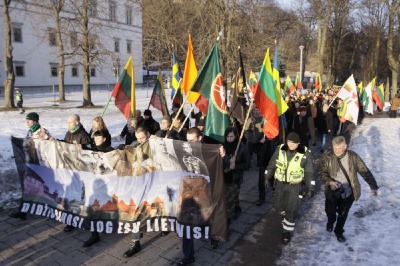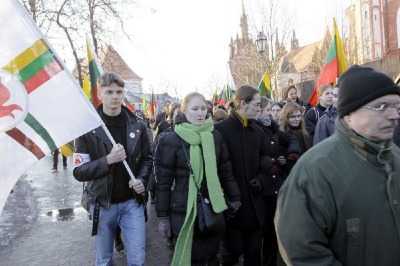Sanctioned by the Municipality of Vilnius on a route that included Vilna’s destroyed old Jewish cemetery …

11 March 2010. Elderly Jewish survivors were shaken to the core by this latest Neo-Nazi march in downtown Vilnius on Lithuania’s March 11 Independence Day. The march was sanctioned by the city municipality. The permit was requested by a member of parliament from the governing party. And in a final flourish of inflicted pain, the approved route included the territory of the dismantled Old Vilna Jewish cemetery. All this marred the twentieth anniversary of the country’s bold breakaway from Soviet tyranny and its inspiring transition to a modern democracy, a magnificent achievement celebrated by all the country’s communities. More photos and reports: Balsas.lt. Delfi.lt. Video by Lietuvos rytas.
Background. Once again, the government’s ‘red-equals-brown’ Holocaust Obfuscation movement played its part. In June of 2008, the country’s parliament had passed a law forbidding both Nazi and Soviet symbols. This struck observers as somewhat curious, given that there are no ‘pro-Soviet’ marches, and the only people to be offended were very elderly veterans who cherished their victory over Hitler. The ultranationalist and neo-fascist movement, however, lost little time in proliferating an array of swasticals, a term we introduce to cover the ‘whole lot’ of swastika-inspired symbols used by ultranationalists, racists and neo-Nazis in the course of activities against ethnic, religious and sexual minorities, and against foreigners. By marching with ‘three-legged’ swastikas, with the ‘Lithuanian swastika’ and other variations, the neo-Nazis seem to have ‘outwitted’ lawmakers who seem quite unperturbed and content to be ‘outwitted’. Moreover, attempts to resurrect and march around with prewar swastikas as ‘art’ or as a claimed ‘national symbol’ are gaining some traction. Analogously, the ‘Lietuva Lietuviams’ (Lithuania for Lithuanians) chant, replacing the ‘Juden raus’ of two years ago (see Antisemitism → 2008, 11 March), seemed to make it all wholesome and legal for the authorities.
White armbands are back. For the aged Holocaust Survivors interviewed since the march, the most painful symbol was, however, not the swastika. It was rather the white armbands worn by some marchers, celebrating the infamous ‘activists’ who set the Lithuanian Holocaust in motion by murdering innocent civilian Jews in dozens of towns before the actual arrival of the Germans in the last week of June 1941. When Nazi forces arrived, ‘the white armbands’ became Hitler’s murderers par excellence. The flaunting of the armband on the streets of central Vilnius in 2010 is a grievous stain on the entire region. It is nevertheless hoped, in spite of recent setbacks on the freedom-of-speech front, that major politicians, academics, intellectuals, law enforcement authorities and other elites will this time act rapidly — and convincingly.

